#laravel developer start kit
Explore tagged Tumblr posts
Text

🚀 Unbeatable Opportunity for Developers & Resellers – Limited Time Offer!
Boost your digital products business or elevate your development game with this Exclusive Bundle of premium resources. Packed with value, this deal is your key to creating, selling, and thriving!
🔥 What’s Inside the Bundle?
A. 10,000+ Premium Themes
For WordPress, Shopify, Joomla, and more! Build stunning websites effortlessly with high-quality, versatile themes.
B. 7,000+ Code Scripts
Includes Laravel, Flutter, PHP, Unity Game Source Codes, and more! Perfect for eCommerce, cross-platform apps, gaming platforms, and beyond.
C. 1,000+ Elementor Kits Templates
Pre-designed templates for ultra-fast website creation.
🌟 Why Choose This Bundle?
Unlimited Possibilities: Create professional websites, apps, and games with ease. Resell for Profit: Fully activated products with commercial licenses. Premium Quality: Build WordPress sites, Laravel projects, Unity games, and more effortlessly. Verified & Active: 100% reliable and ready-to-use files.
🎥 See It for Yourself
Explore the demos before buying:
A. All Demo Product List - Link - https://shorturl.at/bOkbE
B. Download all Demo - Link - https://rb.gy/122bvm
Need personalized demos? Message us anytime!
🕒 Why Act Now?
This is a LIMITED-TIME OFFER – don’t miss your chance to grab this ultimate bundle and start your journey to success today!
📞 How to Get Started?
💬 WhatsApp: https://wa.me/message/C5NZKA2G2XAJE1 🌐 Website: https://marketfav.com/ 📧 Email: [email protected]
Turn your vision into reality – build, sell, and grow with this exclusive bundle! 🌟
#themes bundle#code scripts#elementor kits#wordpress themes#shopify themes#joomla themes#laravel scripts#flutter scripts#php scripts#unity game source code#eCommerce tools#app development#game development#website templates#premium themes#reseller license#commercial license#activated files#verified products#cross-platform apps#gaming platforms#wordpress design#shopify design#joomla design#elementor templates#web development#app creation#website building#stunning websites#demo files
0 notes
Text

🚀 Big Opportunity for Developers & Resellers – Only Limited Time Offer! We sell 18000k+ Code Scripts & Themes Bundle Package Full Active & License
Looking to kickstart your digital products business or take your web & app development to the next level? Look no further! We're offering a game-changing bundle to help you create, resell, and grow like never before!
🔥 What’s Included in This Exclusive Offer:
A. 10,000+ Premium Themes Bundle
Comprehensive themes for WordPress, Shopify, Joomla, and more! Effortlessly build stunning websites with ease.
B. 7,000+ Code Scripts Bundle
Includes Laravel, Flutter, PHP, Unity Game Source Code, and more! Perfect for building eCommerce websites, cross-platform apps, gaming platforms, and beyond.
C. 1,000+ Elementor Kits Template Bundle
Ready-to-use Elementor templates to speed up website creation.
Why Choose Us?
Unlimited Possibilities: Build professional websites, apps, and games with ease. Resell for Profit: All products come with commercial licenses, letting you resell legally. Active & Verified Products: Enjoy worry-free usage with fully activated files. Premium Quality: Design stunning WordPress sites or launch complex Laravel projects effortlessly.
Demos Available!
We want you to explore before you buy! Check out the demo files here:
A. All Demo Product List - Link - https://shorturl.at/bOkbE
B. Download all Demo - Link - https://rb.gy/122bvm
Need more demos? Contact us on WhatsApp anytime! WhatsApp: https://wa.me/message/C5NZKA2G2XAJE1
Why Act Now?
This offer is limited time only, so don’t miss your chance to grab this incredible deal and start building your dream business today.
How to Get Started?
💬 WhatsApp: https://wa.me/message/C5NZKA2G2XAJE1 🌐 Website: https://marketfav.com/ 📧 Email: [email protected]
Turn your vision into reality. Start your journey today!
#developerbundle#codescripts#premiumthemes#resellerdeal#webdevelopment#appdevelopment#laravelscripts#fluttersourcecode#wordpressdesign#shopifythemes#elementorkits#limitedoffer#digitalproducts#businessgrowth#marketfav
0 notes
Text
Metronic HTML Template: Elevate Your Best Web Design Game
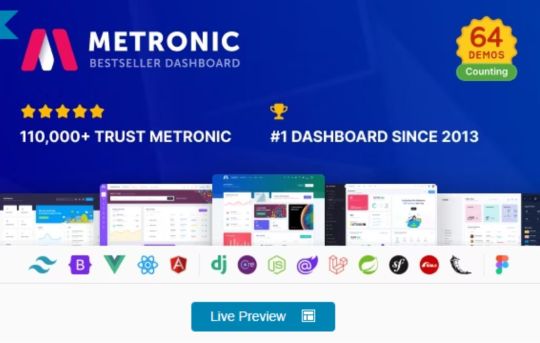
Are you looking for a reliable admin dashboard template to power your next project? Look no further than Metronic Html Template! This powerful tool is designed to help you create beautiful and intuitive admin interfaces that will impress your clients and users alike.
In this review, we’ll take a closer look at what makes Metronic Html Template such a great choice for developers and businesses alike. We’ll explore its features, functionality, and compatibility with popular frameworks like Tailwind, Bootstrap, React, Vue, Angular, Asp.Net & Laravel. So, let’s dive in!
Features
Metronic Html Template comes loaded with a wealth of features that make it an excellent choice for developers and businesses alike. Some of its standout features include:
– High Resolution: Metronic Html Template is optimized for high-resolution displays, so your dashboard will look crisp and clear on any device. – Responsive Layout: The template is designed to be fully responsive, so your dashboard will look great on any screen size.
– Well Documented: Metronic Html Template comes with comprehensive documentation to help you get up and running quickly.
– Compatible Browsers: The template is compatible with all popular web browsers, including Firefox, Safari, Opera, Chrome, and Edge.
– Compatible With: Metronic Html Template is compatible with Angular 13.x.x, AngularJS, ReactJS, Bootstrap 5.x, Bootstrap 4.x, and other popular frameworks.
– Admin Dashboard Template: Metronic Html Template is designed specifically for use as an admin dashboard template, so you can be sure it has all the features you need to create a powerful and intuitive dashboard.
– Admin Themes: The template comes with a range of pre-built themes to help you get started quickly.
– PHP Files: Metronic Html Template comes with all the PHP files you need to get started quickly.
– HTML Files: The template comes with a range of pre-built HTML files, so you can get started quickly.
– CSS Files: Metronic Html Template comes with a range of pre-built CSS files to help you customize your dashboard.
– Sass Files: The template includes Sass files for advanced customization.
– SCSS Files: The template includes SCSS files for advanced customization.
– JS Files: Metronic Html Template includes a range of pre-built JavaScript files to help you get started quickly.
Compatibility
Metronic Html Template is compatible with a wide range of popular frameworks and platforms, including:
– Tailwind – Bootstrap – React – Vue – Angular – Asp.Net & Laravel
This makes it an excellent choice for developers who want a flexible and versatile tool that can be used with a variety of different frameworks and platforms.
12 Advanced Apps For Real-world Demands
Complete CRUD solution with managable datatables, advance form controls, wizards flows and interactive modals for any project requirements you can imagine
Metronic UI Kit Develop Design Fast
Create cohesive user interfaces for single or multiple projects without having to start from scratch. Metronic UI Kit is helpful for designers who are just starting out or who are working on projects with tight deadlines.
Company made it! Smart & Low-cost!
One stop solution that boosts your projects’ design and development at shortest amount of time and at ridiculously low cost. In the past 10 years, hundreds of thousands of web apps successfully launched by Metronic that are used by hundreds of millions of end users everyday
Pricing
Metronic Html Template is available for purchase on ThemeForest for just $49. This includes a Regular License, which allows you to use the template in a single end product that is not charged for. If you need to use the template in a product that will be sold to end users, you can purchase an Extended License for $969.
If you purchase the Regular License, you’ll receive quality checking by Envato, future updates, and six months of support from keenthemes. You can also extend your support to 12 months for an additional fee.
Reviews
Mr. Levan Dvalishvili Chief (Software Architect) at solarspace.io said Hands down the most developer friendly package that I have worked with.. A+++++
platform we tried out Metronic. I can not overestimate the impact Metronic has had. Its accelerated development 3x and reduced QA issues by 50%. If you add up the reduced need for design time/resources, the increase in dev speed and the reduction in QA, it’s probably saved us $100,000 on this project alone, and I plan to use it for all platforms moving forward. The flexibility of the design has also allowed us to put out a better looking & working platform and reduced my headaches by 90%. Thank you KeenThemes! Jonathan Bartlett, Metronic Customer
Metronic is an incredible template. Even with purchasing an extended license, the cost savings is immeasurable. The code & CSS is well organized and while it is feature rich, it is not bloated. It was quickly integrated into our relatively complex product and had ready-made UX for our many use cases. Where we needed to extend functionality, this system made it incredibly easy. A tremendous job by the Metronic team. Fatica, Metronic Customer
Conclusion
In conclusion, Metronic Html Template is an excellent choice for developers and businesses alike. It comes loaded with features, is compatible with a wide range of popular frameworks and platforms, and is available at an affordable price. Whether you’re building a new dashboard from scratch or looking to upgrade an existing one, this Template is definitely worth considering.
So, what are you waiting for? Head over to ThemeForest and check out Metronic Html Template today!
#admin dashboard template#admin themes#angular#asp.net core#blazor#bootstrap#bootstrap 5#django#html#laravel#metronic#react#tailwind#tailwind css#vuejs
0 notes
Text
LUNO Admin Template - Your Gateway to Stylish Dashboards by Thememakker
Are you ready to revolutionize your dashboard experience?
Introducing Thememakker's LUNO admin template, the ultimate solution for modern and stylish dashboards!
With LUNO Mega Bundle, you gain access to company support, 10+ layouts, 500+ HTML pages, and much more.
Explore the incredible features of LUNO Admin Template, such as dynamic font settings, LTR and RTL support, and easy template customization.
With 10+ business niche concepts, LUNO will meet all your business requirements. It's time to take your projects to the next level.
For a seamless experience, get all HTML, CSS, SCSS, and JS files, along with a starter kit.
Choose the license that suits you best, whether it's the Regular License ($18) or the Extended License ($999).
Our dedicated support team is here to assist you.
Contact us anytime via live chat or email at [email protected].
Don't miss out on the dashboard revolution. Embrace LUNO Admin Template and elevate your digital journey today!
#LUNOAdminTemplate#DashboardRevolution#StylishDashboards#LUNOMegaBundle#WebDevelopment#BusinessNiche#HTMLTemplates#DashboardDesign#DigitalJourney#Thememakker
URL: https://www.wrraptheme.com/templates/luno/marketing/
For more details visit https://www.Thememakker.com/
Thememakker Infotech LLP
B-906/907, Titanium Heights,
Corporate Rd, Prahlad Nagar,
Ahmedabad (India) – 380015
Call: 7573830505
Email: [email protected]
Follow Us,
https://www.linkedin.com/company/thememakker/
#webdevelopmentcompany#youtube#web developers#developmentcompany#webdesign#mobileappdevelopment#appdevelopment#seo#apiintegration
0 notes
Text
Chandra - Laravel Admin UI Kit
Chandra – Laravel Admin UI Kit
Chandra admin template is beautifully crafted admin template for backend applications. Starting a Laravel project? Save tons of hours with built-in blade templates, users management etc. Features Built with Bootstrap 3.3.4 Valid HTML 5 and CSS 3 6 color schemes Different layout options Multi level menu 40+ pages included 100+ components used Boxed & Full width versions available Fully…

View On WordPress
#Laravel#laravel admin#laravel admin for beginners#laravel admin template#laravel bootstrap kit#laravel developer start kit#laravel starter kit
0 notes
Text
Chandra - Laravel Admin UI Kit - Laravel
Chandra – Laravel Admin UI Kit – Laravel
Chandra – Laravel Admin UI Kit – Laravel LIVE PREVIEWBUY FOR $26 Demo Download Details
[ad_1]

Chandra admin template is beautifully crafted admin template for backend applications.
It comes with HTML, PHP and Laravel versions
You can use it for any language like PHP, ASP, JSP, perl, ruby etc…
Starting a Laravel project? Save tons of hours with built-in blade templates, users management etc…

Features
View On WordPress
#admin#Chandra#Kit#laravel#laravel admin#laravel admin for beginners#laravel admin template#laravel bootstrap kit#laravel developer start kit#laravel starter kit
0 notes
Text
What are the pros and cons of Laravel?

If you are well versed with the software development industry then the name Laravel would not be a strange one to you. Laravel has a tremendous ecosystem supported by a large community of developers. Because Laravel is one of the most used PHP frameworks, the library of available Laravel applications and packages is substantial. Both official Laravel packages and third-party packages are readily available. However like every other picture Laravel too has two sides. Today we discuss that. We discuss the pros and cons of using Laravel
Pros of using Laravel
Easy to learn: Many web developers agree that Laravel is among the more accessible web frameworks. That’s thanks to the thorough user documentation that is available in the simplest form. Also, the software includes PHP screencasts which are easy to understand.
Using its built in capabilities like Eloquent, the Schema Builder, and Blade templates make mundane tasks quick and easy. Laravel framework shows amazing data model and is expandable to suit your needs, whether it be a small business or a corporate enterprise at scale.
Laravel has a wide range of features.
Laravel framework development describes itself as a progressive framework, meaning that it includes a variety of functionality that users of all levels will find useful. For example, beginners have access to starter kits for modules such as basic authentication features. Many of these tools are discussed in greater detail below.
One of them is Laravel which we discussed earlier. Laravel is known as a framework that has complete features, has functions that facilitate the process of making websites maximally and dynamically. As well as saving costs and time, as well as the most widely used by companies and developers.
Laravel is fast and efficient.
Without a doubt, It may be said that Laravel is a near -perfect framework for web development. Laravel web development is rising because of its genuine qualities- it’s faster, better, highly cost-effective, and can build scalable web applications. You can create beautiful applications using Laravel.
Laravel is highly scalable. With integrated support for fast, distributed cache systems, Laravel applications are capable of addressing millions of requests per month. Laravel also offers a serverless deployment platform, Vapor, which is based on AWS and provides a high degree of scalability.
Cons of using laravel
But all developers know that not all frameworks are perfect; every framework comes with pros and cons. In this article, you will know the above larval pros and cons with detailed information. Before we start into the pros and cons, let’s know about Laravel.
Let’s start with a fact that is rarely taken into account. Many programmers sell their services within the tech stack they are good at. Few of the highly skilled professionals are willing to admit that the programming language they have mastered is troublesome or too complicated. And yet, every programming language and every software solution has its pros and cons. The ideal one does not exist but some win over the others. We are talking about Laravel.
Laravel may be too complex for some users.
Big projects often demand complex features and functionality integration that eventually consumes much time and effort. You can unhesitatingly utilize Laravel for such projects but make sure that you’re using the best development practices so that the project’s quality doesn’t hamper.
Several features of Laravel could be simplified. First, it is heavy documentation that not all programmers can cope with at first. However, the support of Laravel and the online developer community can make the initial stage of working with the framework as painless as possible.
Laravel has some known vulnerabilities.
When it comes to data security, Laravel doesn’t disappoint. To protect your data from common vulnerabilities like SQL injections, cross-site scripting, and cross-site forgery, Laravel has several security features like easy-to-implement authentication and authorization processes and a secure codebase.
Authentication is one of the core areas that Laravel tries to improve security with an out-of-the-box solution available at app/config/auth.php. Laravel provides options for hashing and encrypting passwords, authenticating users, forcing password resets and security minimums, and several other important rules that provide strong access control.
0 notes
Video
youtube
With the beginning of 2019, I've decided to code a little startup. I've been programming in an advertising agency for 5 years now and have 8 years experience. I love to code for a hobby and found out this could be a good start to make something on my own. Either for profit or just for fun. The weapon of choice is Laravel 5.5. The frontend will be based on Vue.js Watch other videos from this series: - Part 1: https://youtu.be/n9GzppuVgfs - Part 2: https://www.youtu.be/KjKBqC1ktBM If you are a beginner then I hope you've learned something from this video. If something is unclear, feel free to write a comment and I'll try to answer it. If you are a professional and would like to give me an advice, please leave a comment, I'd be happy to make the app better and learn something new. Find this video helpful in any way? Be sure to drop a like & comment to motivate me to make more videos like this: https://goo.gl/S7S5wU Don't forget to click the "bell" next to the subscribe button and select "Send me all notifications for this channel". Check out my gear on Kit: http://bit.ly/2VuRVp8 About the framework: Laravel is a free, open-source PHP web framework, created by Taylor Otwell and intended for the development of web applications following the model–view–controller (MVC) architectural pattern and based on Symfony. Some of the features of Laravel are a modular packaging system with a dedicated dependency manager, different ways for accessing relational databases, utilities that aid in application deployment and maintenance, and its orientation toward syntactic sugar. The source code of Laravel is hosted on GitHub and licensed under the terms of MIT License. http://bit.ly/2AeAxtq Social Networks: - Instagram: http://bit.ly/2VjOQrX - Twitter: https://www.twitter.com/_colorscream - Facebook: http://bit.ly/2QgvHDi - Patreon: http://bit.ly/2Vm2zOG Music credits: Waking Dreams - Moments Andy Leech - I Love You AK & Mapps - IV Wiljan & Xandra - Woodlands DNZ - Wanderlust Wiljam - Faraway AK - Our Destination Broke For Free - Smoke Sill Nomyn - The Journey Sappheiros - Embrace Cash - Heaven Above Ferven - Scattered Thoughts Whithe - Smoother Here we go channel: http://bit.ly/29etmV2 http://bit.ly/29dFWaQ http://youtube.com/c/HearWeGoCopyrightFreeMusic https://twitter.com/hearwegochannel http://bit.ly/29etuE1 Photo credits: luis gomes / pexels.com #startup #livecoding #laravel
1 note
·
View note
Text

🚀 Big Opportunity for Developers & Resellers – Only Limited Time Offer! We sell 18000k+ Code Scripts & Themes Bundle Package Full Active & License
Looking to kickstart your digital products business or take your web & app development to the next level? Look no further! We're offering a game-changing bundle to help you create, resell, and grow like never before!
🔥 What’s Included in This Exclusive Offer:
A. 10,000+ Premium Themes Bundle
Comprehensive themes for WordPress, Shopify, Joomla, and more! Effortlessly build stunning websites with ease.
B. 7,000+ Code Scripts Bundle
Includes Laravel, Flutter, PHP, Unity Game Source Code, and more! Perfect for building eCommerce websites, cross-platform apps, gaming platforms, and beyond.
C. 1,000+ Elementor Kits Template Bundle
Ready-to-use Elementor templates to speed up website creation.
Why Choose Us?
Unlimited Possibilities: Build professional websites, apps, and games with ease. Resell for Profit: All products come with commercial licenses, letting you resell legally. Active & Verified Products: Enjoy worry-free usage with fully activated files. Premium Quality: Design stunning WordPress sites or launch complex Laravel projects effortlessly.
Demos Available!
We want you to explore before you buy! Check out the demo files here:
A. All Demo Product List - Link - https://shorturl.at/bOkbE
B. Download all Demo - Link - https://rb.gy/122bvm
Need more demos? Contact us on WhatsApp anytime! WhatsApp: https://wa.me/message/C5NZKA2G2XAJE1
Why Act Now?
This offer is limited time only, so don’t miss your chance to grab this incredible deal and start building your dream business today.
How to Get Started?
💬 WhatsApp: https://wa.me/message/C5NZKA2G2XAJE1 🌐 Website: https://marketfav.com/ 📧 Email: [email protected]
Turn your vision into reality. Start your journey today!
#developerbundle#codescripts#premiumthemes#resellerdeal#webdevelopment#appdevelopment#laravelscripts#fluttersourcecode#wordpressdesign#shopifythemes#elementorkits#limitedoffer#digitalproducts#businessgrowth#marketfav
0 notes
Photo

15 Best Flutter Mobile App Templates for Communication
Do you want to build and deploy fast, beautiful social media or communication apps for both Android and iOS?
Then you should consider creating a Flutter app. Using Flutter, you can write apps for both Android and iOS using a single codebase. And a Flutter app template makes it easy to get started.
What Is Flutter?
Flutter allows developers to build beautiful, natively compiled apps from a single codebase for both Android and iOS.
Flutter is now one of the most popular frameworks for developing cross-platform mobile apps. In addition to being a first-class platform for Material Design, developers consider it to be a great alternative to popular cross-platform frameworks like React Native, Ionic, and so on.
Flutter widgets abstract all critical platform differences such as scrolling, navigation, icons, and fonts to provide full native performance on both iOS and Android.
On CodeCanyon, you will find all the tools you need to start building your app with Flutter. With a Flutter app templates, all the coding has been done beforehand, you just need to concentrate on what makes your app unique.
Best Flutter App Templates for Communication
Communication apps have become crucial in today's world. On CodeCanyon you will find templates that will help you build apps that meet every communication needs.
Here are some of the best-selling Flutter mobile app templates to download on CodeCanyon for 2020.
15 Best Flutter Mobile App Templates for Communication
Let us have a look at some of the best Flutter mobile app templates for communication available on CodeCanyon.
I have divided them into the following categories: social media apps, video conferencing apps, dating apps, chat apps, and news apps.
Flutter Social Media App Templates
1. Trending: TikStar—TikTok Clone App UI in Flutter UI Template
TikStar is a TikTok clone and short video streaming mobile app UI template. TikStar was developed using Flutter. That means that the UI is compatible for both Android and iOS.
This social media Flutter mobile app has clean, well-formatted code that is easy to understand.
Features you will find in this amazing app include:
login, signup, and forgot password screens
login with phone number screen
OTP verification screen
carousel slider
animation
2. QVid—TikTok Clone App Flutter Template
Qvid is a social media video app for creating and sharing quick short personal, musical, comedy, and talent videos. This awesome looking social media Flutter mobile app comes with over 30 screens to choose from. It is easy to customize and reskin.
As a TikTok clone Flutter app template, it can also be used to build clones that closely resemble other popular apps.
3. Flutter Storyteller—Social Media Platform
Flutter Storyteller is a social media platform Flutter template which can help you build your own social app. It has a beautiful UI that is easy to customize thanks to the clean and reliable code of this Flutter social app.
Built using Flutter and with Laravel on the back-end, it comes with full, easy-to-use, step-by-step documentation.
4. HeyP—Flutter Social App
HeyP is an elegant Flutter social app that to helps uses connect with family and friends.
It comes with more than 16 screens and 40 widgets to help you customize your app.
The back-end is based on Node.js, and uses Firebase for push notifications. The same code is used for both iOS and Android.
Flutter Video Conferencing App Templates
5. MeetAir—Video Conferencing App for Live Classes
MeetAir is complete video meeting system that you can use to start your online meeting platform. You can use it for: video meetings, live classes, webinar, online training, web conferences, and more. It has a powerful admin panel to manage meetings, history, notification, analytics, and app configuration.
Using this Flutter app template you can build your own web, Android, and iOS video conference apps. No coding is required to use this video conferencing Flutter app template.
Other impressive features include:
lock-protected rooms to control access to your conferences with a password
schedule and add the meeting to your calendar.
chat and message with your team during meetings
high quality audio and video delivered with the clarity and richness of Opus and VP8
6. AeroMeet—Flutter Video Conference
AeroMeet is an online meeting platform to manage video conferences, live classes, meetings, webinars, and online training. It uses Agora SDK which is very popular for video calling and is a fast growing platform.
Some features of this highly configurable platform include:
secure and encrypted call.
host and join meeting from mobile.
mandatory login enable/disable.
unauthorized meeting ID protection.
meetings history
7. Connect—Video Conferencing App
Connect is a secure video conference platform where anyone can create an account and get connected to their loved ones without worrying of data theft.
This Flutter video conference app supports up to 70 people in a single conference call. You can create meetings with extra secure passcodes provided by Google. In addition, you can receive feedback from users on your desired email account.
Flutter Chat App Templates
8. Flutter Firebase Chat
Flutter Firebase Chat is a real time chatting app with video calling support based on Flutter, Firebase, and Agora.io. This Flutter chat mobile app template integrates a chat functionality into any existing Flutter app. Also you can easily customize and refine it for yourself, since it uses the BLoC pattern.
Main features of this app include:
one-to-one chat and video calls via Agora.io
group chat
image sharing
email authentication
9. Flutter Chat App With Node and MongoDB
This Flutter chat app is a versatile mobile chat system developed in the Dart language using Node.js for the back-end.
Admin accounts can delete posts and comments. They can also add and delete public chat rooms. Users can search for other users using email, read messages, and send text or images.
This app template comes with full Flutter source code, full Node.js back-end code, and extensive documentation including screenshots.
10. FlutterFire Social: Chat and Messenger
FlutterFire Social is a fully functional Flutter social messenger app with a Firebase back-end, You can post, like, comment and chat with people and more.
Other features include:
Firebase email authentication
realtime chat with online users
a group chat system including the ability to create and edit groups
admins can post, edit and delete
block and unblock users
Flutter Dating App Templates
11. Hookup4U—Complete Flutter Dating App
Hookup4U is a complete Flutter dating app template. Admins can change usernames and passwords, and have a detailed user viewer to search users, block users, and more. In addition, admins can create packages that include free and paid subscriptions.
Other features include:
authentication with Facebook and phone number (OTP based)
settings for profile visibility
like or unlike other profile pics based on settings
show matches
one-to-one text chat
one-on-one audio and video chat (Agora based)
12. Hookup4U—Tinderlike Flutter Dating UI kit
Hookup4u is a hybrid mobile dating app template in Flutter. It has all the UI you will find in a regular dating app. You can use this Flutter app template to create a fully functional dating app.
Some screens you will find in this UI kit include:
welcome
splash screen
login using Facebook and phone
verify OTP
Flutter News App Templates
13. Deco News Flutter App for WordPress
News apps are very popular but not everybody has the time and resources to build their own news app from scratch.
The Deco News Flutter Mobile App for WordPress converts your WordPress website into a native app that delivers news content on both Android and iOS.
14. FluxNews—Flutter Mobile App for WordPress
FluxNews is an app converts your Wordpress website into a mobile true native app with customized contents. No coding skill is required. It comes with a very clean design that is easy to customize. You can build your own app by using over 50 resuable widgets.
FluxNews maximizes your customer’s experience and usability through UX flow in both Android and iOS.
Additional features include:
offline images caching to speed up the loading performance
instant synchronization for smooth data update without downtime
support social login, SMS login by Facebook
15. News Hour—Flutter News App with Admin Panel
News Hour is complete news app with admin panel that is developed in Flutter.
It comes beautiful interactive user interface. There are 40 screen layouts to choose from. It has animation on every screen, making it one of the most user-friendly Flutter news app templates.
Users can login using Google and Facebook, search news categories, bookmark content, and also leave comments.
Build Your Flutter Mobile App Now!
A complete app developed from scratch will have a lot of components, screens, and functionality representing many hundreds or thousands of hours of developer time. That's a lot of time and effort on your part! The Flutter mobile apps templates available on CodeCanyon will shortcut this process and greatly save on development cost.
Google Flutter From Scratch Series
If you want to get started coding apps with Flutter, check out the Google Flutter From Scratch series on Envato Tuts+:
Android
Google Flutter From Scratch: Using Firebase Services
Ashraff Hathibelagal
Android SDK
Google Flutter From Scratch: Building Apps With Widgets
Ashraff Hathibelagal
Android SDK
Google Flutter From Scratch: Animating Widgets
Ashraff Hathibelagal
Android SDK
Google Flutter From Scratch: Grids, Lists, and Data Sources
Ashraff Hathibelagal
Android
Coding an Android App With Flutter and Dart
Ashraff Hathibelagal
And if you want even more Flutter app templates, check out my other post here on Envato Tuts+.
Flutter
23 Best Flutter Mobile App Templates on CodeCanyon
Franc Lucas
by Franc Lucas via Envato Tuts+ Code https://ift.tt/3cN311I
0 notes
Text
The Leading Web Tools and Services in 2020

Even with 2020 starting with a huge pandemic — a crisis that has affected many people and businesses — some of the web tools and services that are very popular are doing extremely well.
In this article, you’ll find out more about the leading web tools and services in 2020. There are over 30 solutions from various fields: UI Kits, templates and dashboards; a complete package of services for WordPress; different logo creators; some of the most used WordPress themes; website builders that can be used with 0 experience with awesome results; and much more.
Here goes.
1. Creative Tim

Creative Tim offers both students and professionals fully coded UI tools to create web and mobile apps. They are built on top of Bootstrap, Vue.js, React, Angular, Node.js and Laravel, and each of these technologies has a FREE version.
What does a free version contain? Let’s take, for example, the most popular kit, called Material Kit.
Along with the restyling of the Bootstrap elements, you’ll find three fully coded example pages, two plugins, and 60 elements, inspired by Google’s Material Design.
Creative Tim also offers developers six Bundles, one for each technology. Everything included in the products can be downloaded for free under MIT License. On the website, you’ll also find pre-made section and elements, admin templates, and fully coded dashboards.
If you don’t know them, check out their website and their Facebook page.
2. 48HoursLogo.com

Need a creative logo design on a tight budget? 48hourslogo is proud to offer the most affordable logo design contest on the Internet. Customers simply post a design brief, receive 20+ logo concepts and select their favorite design. For just $99, customers can expect maximum creativity and unlimited logo revisions and exclusive logo copyright.
48hourslogo has connected freelance designers with entrepreneurs and brands across the world for more than 10 years. Since 2009, 48hourslogo has helped more than 65,000 small businesses and entrepreneurs creating their logos. Their designer community has uploaded more than 5 million logos in the process making them one of the top logo design websites on the Internet. If you’re still not sure if a logo contest is right for your brand, you can start a contest for just $29. Take a look at the designs submitted before paying full contest prize.
3. UPQODE Web Design Agency

UPQODE is an award-winning, customer-focused, quality-driven digital marketing and web design agency specializing in WordPress. As a values-driven company, they work one-on-one with you to take your online vision and turn it into reality through innovative, sleek and powerful websites that drive traffic and increase brand recognition.
Their goal is to exceed your expectations, and they do that by working with care and openness.
By taking time to understand your goals and business objectives, they strive to be your partner in this process not just your “developers”.
With the transparent workflow that provides you insight into the process and rolling design approval, they know that the only way to create your online success is together.
4. Total Theme

Total is the perfect WordPress theme, being loaded with everything you need to easily design hundreds of unique websites. You’ll find included 80+ builder modules, 40+ pre-made demos, 500+ styling options, and a drag-and-drop builder that will hugely help you along the way.
This WordPress theme is very different from all the others. Total is very fast, flexible, fully responsive, easy to work with, all the demos can be installed with one click, and it will make your website look exactly as in the demo, and much more.
Check out Total. This all-in-one WordPress theme will help you create gorgeous websites. If you need support with your SEO performance and Logo Designing, experts of Web Developer in Pagosa Springs, CO can help you, just drop your comments in the comment section.
0 notes
Text
12 Best CMS for 2019

2019 is half over, but don’t let that stop you from trying something new… specifically, a new CMS. “But Ezequiel, good buddy, I don’t have time to check out a whole new content management system. I have websites to make!”, you say, in those exact words.
That’s fair, but you should be keeping an eye on the up-and comers anyway. These are the people who have the sheer brass walnuts (which are a real thing, unisex, and available to anyone with money) to go up against giants like WordPress, Joomla, and mostly WordPress. They do this with nothing but a pretty good idea, a GitHub repository, and sometimes some corporate funding of some kind, if they’re very lucky. You ignore them at your own peril.
Well, maybe not peril, but these projects deserve a look.
The CMS that have been selected for this list were (almost) all launched post-2017 (or at least their GitHub repos were), and they’re all free, or at least have a free plan. They’re also all under active development. Let’s get started…
Flextype
Flextype is a simple, PHP7-based, flat-file CMS that’s designed to keep things flexible, allowing you to create more or less anything you want. And I do mean “anything”; Flextype makes it dead-easy to define custom fields for any content entry, and has a built-in theme editor
The actual content editing is easy enough, with a simple WYSIWYG editor, though Markdown support is available via plugin. Doing anything fancy with the content requires the use of WordPress-style shortcodes, though.
All in all, it’s a solid foundation for a CMS, and I can’t wait to see what they do with it.
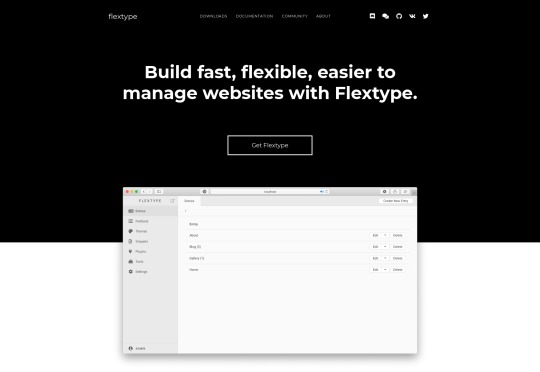
rwtxt
rwtxt is designed to be a simple, searchable notepad where you can jot down notes, keep a journal, or use it as a pastebin. It’s reminiscent of a wiki in that, in its default configuration, anyone can add a page to the public area of the site.
However, you can also add a “domain”, or a sort of personal notepad where you can either keep your private notes private, or make them public and publicly searchable. You can also log into multiple domains at a time, so you could theoretically use rwtxt to run a site with multiple blogs that are thematically different. (You can also add custom CSS to a domain, for further differentiation.)
The whole experience is very bare-bones, but I’m fascinated to see where it goes.
Relevant: rwtxt Github Repo
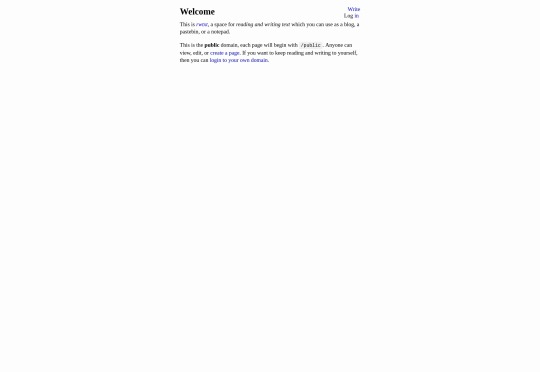
Publii
Publii is one of a few new GUI-focused Static CMS apps that run on the desktop, rather than on your server. You download the app, use it to build a static site, then upload that site onto the hosting of your choice. It’s not a new idea, but it’s one that seems to have picked up steam, lately.
Publii in particular seems to be the most modern and feature-complete of these CMS, and is open source and free to use. It seems to be blog-focused, and there is a marketplace with both free and paid theme options of excellent quality.
Other features include website syncing (supports FTP, GitHub Pages, Gitlab, AWS, Netlify, or Google Cloud), a preview function, a WordPress importer, and a focus on SEO. It’s very definitely focused at more beginner-level users.
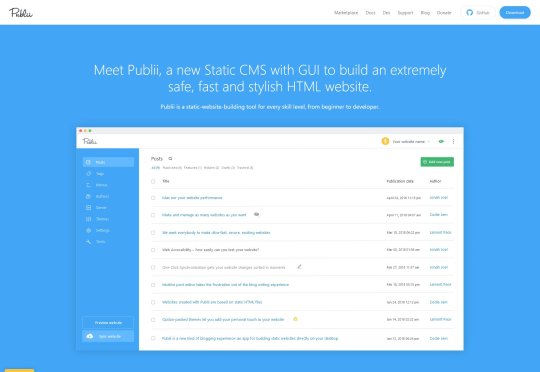
ClassicPress
Speaking, however briefly, of WordPress, ClassicPress is literally a WordPress fork that notably lacks a certain block-based content editor that lots of people disliked. Otherwise, the current version aims to improve security and optimization, remove some bloat, and points the CMS squarely at business users who might be put off by quirky language such as “Howdy”.
The biggest difference so far, besides using the classic content editor, is the governance of the project; there’s a very large focus placed on democracy and voting to determine the future of the project, where WordPress’ future is largely written by Automattic (the company that makes it).
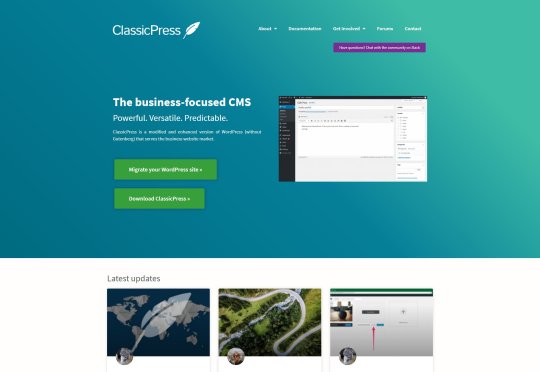
Twill
Twill isn’t strictly a CMS, as such. It’s a “CMS toolkit”, designed to help developers very quickly create a custom CMS to match any need. As such, it’s not something you’d want to install just to start your own blog.
But if you’re a developer, or a business owner who needs a custom-built CMS, it does look like a promising way to get exactly the functionality you need, faster. It’s based on the Laravel PHP framework, so if that’s something you already use and like, try it out.
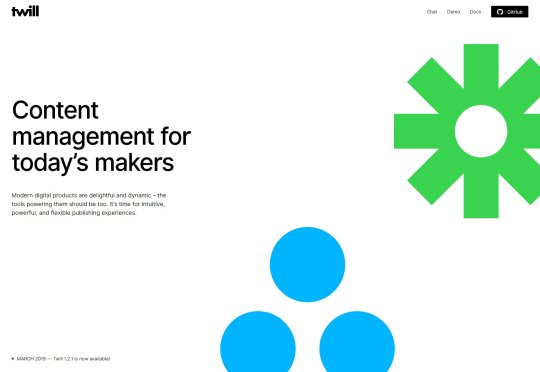
Canner
CannerCMS is similar to Twill in that it’s a build-your-own CMS kit of sorts. Unlike Twill, it seems to be Node-based, so if writing JavaScript is more your style, CannerCMS has you covered.
Incidentally, they also has a SaaS version of the product, which takes care of all the hosting, CDN configuration, and other general hassles for you. The open source edition also apparently lacks multi-language support, which the SaaS version has.
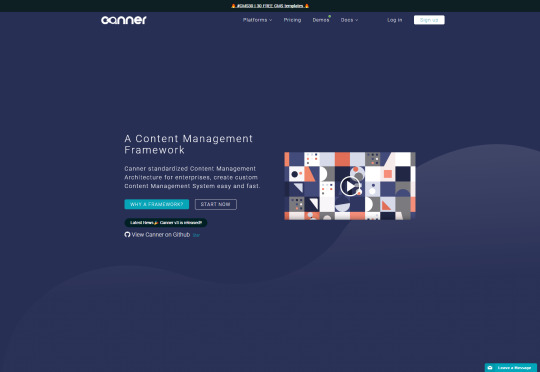
Grafite CMS
Grafite CMS is a sort of dual purpose CMS. By that I mean you can use it as a standalone CMS, on its own and fully functional, or as an add-on to an existing site or web app. Now lots of CMS will allow you to do this via an API of some sort, but Grafite CMS actually comes with two separate setup/installation modes, depending on whether you want to use Grafite CMS on its own, or integrate it into something larger.
It’s also modular, in that content types like “Pages”, Blog”, “Events”, and other are modules that you can activate or deactivate at will. You can, of course, make your own modules if you need a custom content type. It’s very much based on a “use only what you need” philosophy.

Vapid
Vapid has been mentioned once before here on Web Designer Depot, but it’s worth looking at again, in case you missed it. It’s billed as an intentionally simple CMS, and they mean it. The dashboard is literally generated based on the tags you use in your templates. Every time you mark part of a page as editable content, the dashboard will add the appropriate form field in the admin UI.
It’s written in NodeJS, and you can host the app on your own server for free if you know how (the code itself is open source), or you can deploy your website to Vapid’s own hosting service. Publishing your site there does cost money of course, but the plans are quite reasonable, with the first paid plan starting at 7 USD.
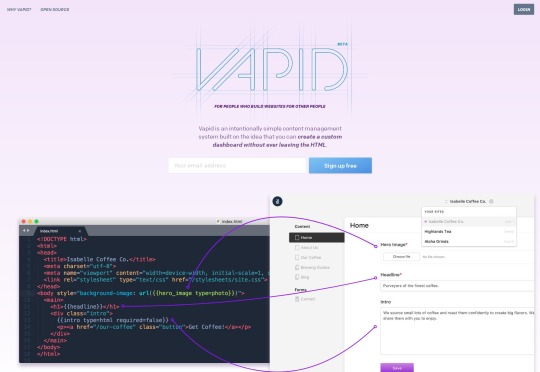
Zola
Zola is a static site generator written in Rust, so it does depend on using a command line interface, but otherwise, they keep development simple. I mean, when’s the last time you heard of a static site generator that didn’t have any dependencies? There are even premade binaries for Windows, Mac, and Linux, so installation is quick and simple.
So yeah, even if you’ve got only a rudimentary understanding of programming like myself, you can probably build sites with Zola. It’s got a list of features about a mile long, including custom taxonomies, LiveReload, Netlify support, shortcodes, image processing, and more. The content is all handled by Markdown, of course.
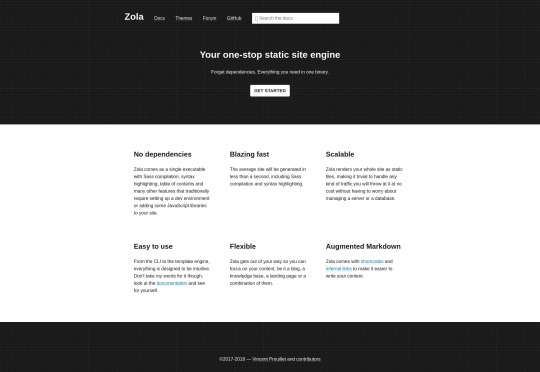
Academic
Academic is interesting because it’s a CMS built on top of another CMS. Specifically, it’s a website / page builder built on top of the Hugo static site generator. It’s designed to take the complexity of a static site generator, and make everything sort of drag and drop. And I do mean everything.
There’s support for easily managing custom pages, talks, slides, tutorials, as well as all the usual content types. There’s multilingual support, and everything can be written in Markdown and, interestingly enough, LaTeX if you’re the math-loving type. Existing themes mostly seem to be Material Design-based, but of course you can make your own.
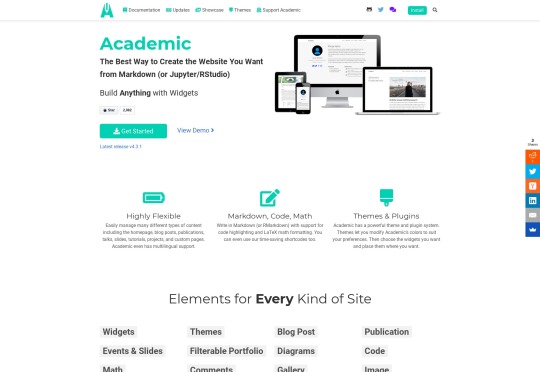
Piranha CMS
I didn’t want our ASP.NET lovers out there feel like we’d forgotten them. For you, Piranha CMS looks rather promising. Interestingly for an ASP.NET CMS, it can run on Windows, Mac, and Linux, with a focus on speed and easy publishing. Considering the tech it’s based on, it’s also Azure-ready right out of the box, if that’s something that matters to you.
Besides all that, you can edit your content as HTML or Markdown, or even plain text. There’s also a Gutenberg-style block editor. There’s image processing, easy internal linking, and even easy ways to run multiple blogs on the same site. The whole thing seems to be aimed at big publishers.
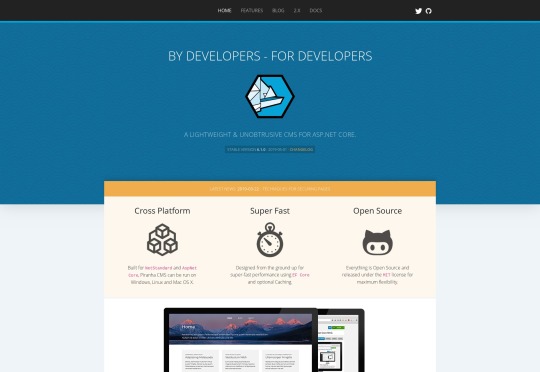
Squidex
Squidex is an ASP.NET-based open source headless CMS (that means they don’t dictate how any of your HTML gets output) that you can run on your own server, or use their SaaS option which also has a limited free plan. It’s the sort of CMS that’s meant to be used as a central repository for all of your content, which you can access anywhere via their API. So theoretically, you could use it to run multiple internal and / or external websites.
As such, it’s the sort of CMS where you sort of have to build your own dashboard, as well as the front end user interface. That said, it does look real good, and offers loads of options to help you build the CMS of your (apparently quite nerdy) dreams.
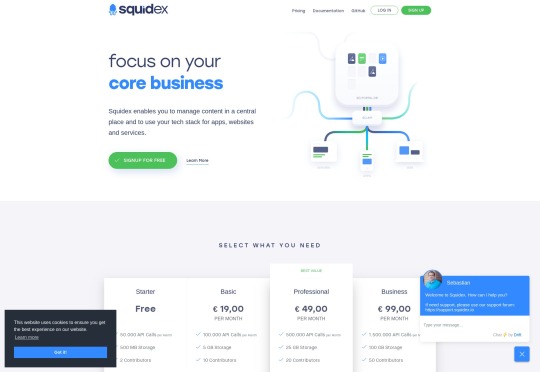
Featured image via Unsplash.
Source via Webdesigner Depot https://ift.tt/2z09XFL
0 notes
Text
Top 10 Web Development Frameworks in 2019
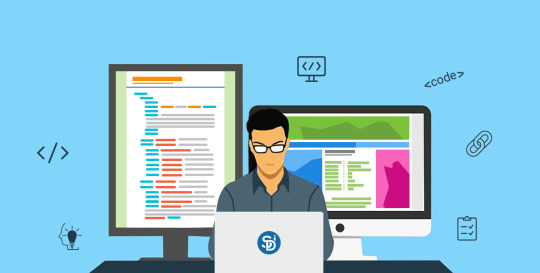
We all are living in such typical Web-arena where satisfying with a low-featured web product is not an intelligent move. One who has a website or app always tries to impress his customers with feature-rich and updated web product. For which, he starts wandering for the best technology and frameworks. A huge list of latest frameworks claiming to be the best generally creates havoc in one’s mind. What to do then… Only a well-versed and experienced web developer can help you. He can suggest you the best web development framework from the pool of several new frameworks that are available in today’s date.
The Important Factors That Are Taken Into Consideration While Doing Ranking
As it is essential for reducing the web complexity, top web development companies like SemiDot, take a sensible approach to help their customers. Our tech specialists have endorsed a catalog of top 10 web development frameworks which are mentioned in this blog post. While doing the ranking of top frameworks, we consider the following important aspects of web development-
Security
Database access
Database configuration
Database mapping
Web services
Web APIs
Web templates
Web resources
Caching
As a top website development company, we take the sheer responsibility to serve solid web frameworks to our valued customers. Know which current frameworks can simplify the complexity of your web product in 2019.
Check-List Of Top 10 Web Development Frameworks On Which People Keep Drooling In 2019
Ruby on Rails
Make your developer happy and give him a joyful environment with Ruby on Rails for your next project. Furthermore, you may find interesting to know that this super-cool framework has come out as a powerful back-end software which is mostly recommended by tech-experts. It is initially released almost twelve years back i.e. on December 2005. Soon after its release, it had started grabbing the attention of the development industry. All credit goes to its ‘easier approach’ and ‘high flexibility’ that make the entire web development- a fun folic process.
2. Symfony
Symfony is the second most favorite framework of mine. It makes the daunting task like web development- a smoother ride. Although it is also an old PHP framework like Ruby on Rails, it ensures you to give extensive web solutions for large-scale projects with amazing features. Another key benefit of using Symfony is- its reusable components which speed-up your app development.
Lastly, it is a mature web framework on which any business can rely on for next coming years.
3. CodeIgniter
CodeIgniter is a lightweight web PHP framework. As the name suggests it makes small-size footprint (its total size is just about 2MB) in your system. It means that you need not to make extra space for this software. Moreover, it has MVC architecture, in-built security toolkit, better error handling and great documentation which make it an ideal framework for making solid performance application.
4. Laravel
Laravel is a popular open-source framework that helps businesses to make their customized applications. Introduced in 2011, it is the most loved software which makes the development process a painless task. It gives you ease of doing common tasks like routing, caching, sessions and authentications. So you can opt this technology for your future complex project. It has the potential. Using which you can easily make a fanatic web product for your web-customers.
5. PHPixie
Launched in 2012, PHPixie is a pumped-up PHP based framework. This prime framework is mainly designed to build read-only websites. For example social networking sites, custom web apps and web development services. As this is relatively new technology, so it lacks in having major community support. Other than this, it is perfect for input validations, standard ORM, authentication, caching and authorization capabilities.
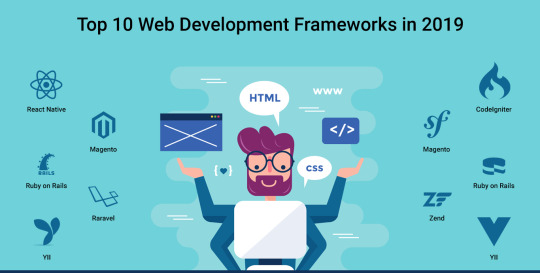
6. Yii
Yii stands out from technology-horde with a bang as it is an easy and evolutionary PHP framework. It is also called as a universal web framework. Using it, you can effortlessly build complex web products. As it endeavors high-performance and speedy web products. People have trust in it. Here is why from building an e-commerce enterprise project to making a simple web portal, you will find that tech-gurus often suggest businesses to deploy their app in this extensive software.
7. CakePHP
Just like its name, CakePHP is a beautiful yet elegant framework that has a well-versed tool-kit. Using which you can build feature-rich and visually impressive websites. Right from its easy installation, it impresses every programmer by offering premium community support and high-quality security features. I would especially like to mention that it is a master choice for making excellent commercial applications.
8. Zend Framework
What prime features of a website put a great impression on its user? Obviously, your answer would be -its robustness, seamlessness, enhanced-security and better performance. Fortunately, you will get all these features in the web product made on Zend framework. Although Zend is a high-geared and exclusive software that is more suited for building big enterprise-solutions. So, you need not to worry about the quality of your final app. With Zend, it is quite obvious that you will get a superior quality, standard mobile app for sure.
9. Vue.js
Vue.js is the most promising latest technology that offers its user a perfect blend of data-binding features and server-side features. Whether you want to make a light-weight app or want to offer effective user-interfaces to your web-users, it is a highly recommended framework that delivers several benefits to its users.
10. React.js
You can also find a solid scope for React.JS in 2019. As of now, it is the best choice for making highly-scalable enterprise’s applications. It is a JavaScript-based framework that is maintained by a group of tech-experts lead by Facebook. Its higher scalability and enhanced security are the basic key-points that generally attract the web developers. Seeing its future scope, its maker is also started thinking to bring an updated version of this software with more features. The name of the updated software would be- React Fiber.
Click here to join hands with best PHP Web Development Company.
0 notes
Text
Laravel Admin UI Starter Kit- Chandra

Chandra Laravel Admin template, version 2.0 has been built on a comprehensive platform which includes Bootstrap 3.3.2 and Laravel 5. The template helps web developers create one of the most compelling well pages for businesses that features 100+ user interface components.
https://codecanyon.net/item/chandra-laravel-admin-ui-kit/9771067?s_rank=2?ref=jyostna.
0 notes
Text
22+ React Developer Tools to Increase Your Programming Productivity [Updated 2021]
New Post has been published on https://flatlogic.com/blog/22-react-developer-tools-to-increase-your-programming-productivity-updated-2021/
22+ React Developer Tools to Increase Your Programming Productivity [Updated 2021]
React Developer Tools Reactide Belle react-styleguidist React Material template React Semantic UI Profiler React Component Benchmark React Developer Toolbox React Bootstrap Admin template Sing App Periscope React wastage Monitor React Studio Atom React Plugin React Extension pack React Style generator Flatlogic One React React Testing Library React Monocle React + Redux kit React Boilerplate Storybook React-Sight
Conclusion
As you can understand from the title of this article, the goal is to be more productive developing React applications. That is why a long intro is unnecessary.
There are only two points that I want to highlight at the very beginning of the article:
This list is opinionated. That means first of all that you can make your additions. I am sure that it can be extended to 30 or even 40 React developer tools. That is why your comments on Facebook or Twitter are highly appreciated. This article can be useful first of all to beginners. That is why I provide some additional historical or background information about React.js in some paragraphs.
React Developer Tools
Reactide
Github stars: 9662 Web-site: http://reactide.io/
Image source: http://reactide.io/
Reactide is an integrated development environment (IDE) for web developers using React.js. If you use this tool, you don’t need server configuration as well as build-tool. Reactide is a React developer tool, it is simply a desktop application that offers great opportunities for visualization thought live code editing.
In Flatlogic we create web & mobile application templates built with Laravel, React, Vue, Angular and Bootstrap to help you develop web & mobile apps faster. Go and check out yourself! See our themes!
Belle
Web-site: http://nikgraf.github.io/belle
Image source: http://nikgraf.github.io/belle/#/?_k=744r8m
This open-source library was built by the members of React community. Belle is a UI framework that was built because of the difficulties with creating a decent UI with React in a short period. Too much freedom with React can lead to a giant waste of time. And that is where the opinionated component library Belle comes in handy. You can easily customize these components, and think only about the features you need to have. Mobile support and consistent API complying with React are also two big pluses of this React dev tool.
react-styleguidist
Web-site: https://react-styleguidist.js.org/docs/getting-started
React development environment. You need to install webpack in order to use this tool. You can see some examples here and here.
React Material Admin
Web-site: https://flatlogic.com/templates/react-material-admin
Image source: https://flatlogic.com/templates/react-material-admin
Admin template is a great React development tool that simplifies the process of coding. The benefits of using admin templates are well known. This particular admin dashboard follows Google material design guidelines. It is completely jQuery and Bootstrap free and can be used for fast development of almost any kind of web application.
Basic Tables; React Router;
Charts; Authentication; Basic Dashboard; Notifications bar.
Do you like this article?
You might want to read “19 Online Tools for Creating Charts”
React Semantic UI
Web-site: https://react.semantic-ui.com/
Image source: https://react.semantic-ui.com/
There is an original Semantic UI library. And to use it in React you need to use a React integration of this library and Semantic UI CSS package. It will help to speed up the development process because of the prebuilt UI components. React Semantic UI is jQuery-free. As you probably know jQuery is a library for DOM manipulation. That is why it is unnecessary to keep real DOM in sync with virtual DOM (React uses JS representation of the real DOM).
Among other features semantic UI React has:
Declarative API Shorthand Props Sub Components Augmentation Auto Controlled State
Profiler
Web-site: https://github.com/reactjs/rfcs/pull/51
Image source: https://reactjs.org/blog/2018/09/10/introducing-the-react-profiler.html
Two years ago the React team introduced Profiler. It gives you a summary of re-rendering of your app. You can increase your debugging performance using this “recording” your set of interactions with the help of this profiling feature. You will be able to see a visualization of re-render as well as screenshots of DOM update.
React Component Benchmark
Web-site: https://github.com/paularmstrong/react-component-benchmark
Image source: https://github.com/paularmstrong/react-component-benchmark
Do you remember react-addons-perf? This tool provided developers with insights about app performance. As the new version of React has been released you can no longer use react-addons-perf. React Component Benchmark is an open-source project that aims to solve the problem of getting an accurate benchmark metric. But it is important to understand that only large enough sample will give you a confident metric. The reason it’s happening like this is that this project does not hook into React directly. And because of this values are not accurate enough. That is why it is reasonable to run large samples using this React development tool.
React Developer Toolbox
Web-site: http://react-toolbox.io/#/
Image source: http://react-toolbox.io/#/
This is the best tool for developing Material Design UI. It has tons of responsive components that comply with Google Material Design guidelines. The exhaustive list you can find right here. React Toolbox is created on top CSS Modules, ES6, and Webpack. Documentation page contains all the live examples of each component so it’s very illustrative.
React Bootstrap
Web-site: https://react-bootstrap.github.io
You can make a case that bootstrap is the largest UI ecosystem in the world. So React-Bootstrap was built for compatibility with Bootstrap. This is one of the oldest libraries for React. It has Bootstrap core, rely on Bootstrap stylesheet and fully evolved side by side with React.js itself. If you want a set of accessible-by-default components React-Bootstrap is giving you much more possibilities than plain Bootstrap.
Admin Templates: Sing App React
Web-site: https://flatlogic.com/templates/sing-app-react
This fully responsive admin template was downloaded more than 1000 times. This template is versatile and was built by professional UI/UX experts. It has more than 60 ready-to-use components and provides you with intuitive framework. It can be useful for building such CRM, CMS, SAAS, etc.
Tens of Pages Fully Responsive 8 Charts Library 2 Dashboards Theme Support E-Commerce Section Static & Hover Sidebar Fully Documented Codebase
Periscope
Web-site: https://github.com/shea-hawkins/periscope
Image source: https://github.com/shea-hawkins/periscope
There isn’t much to say about this open-source project. This is monitoring for Redux applications. You can view your app at all times and adjust the timeline range.
React Wastage Monitor
Web-site: https://github.com/MalucoMarinero/react-wastage-monitor
Image source: https://github.com/MalucoMarinero/react-wastage-monitor#react-wastage-monitor
This project helps you to manage performance issues by detecting wasted rendering time. To understand the importance of this tool you need to dive deep into the concept of <PureComponent>. Implementing PureComponent stops the process called React reconciliation (you can read more here). And PureComponent only re-render when it’s necessary. If you rely on Redux managing to access possible performance mistakes you risk making a critical mistake. React Wastage Monitor ensures you never waste computation on unnecessary renders.
React Studio
Web-site: https://reactstudio.com/
Image source: https://reactstudio.com
React Studio is a useful tool for web developers and web designers. Web developers can enjoy clean JS code, good visual design representation that respects React.js concepts. You can design separate UI components using the code generator. A designer can enjoy responsive layouts that can be easily turned into React code, mobile preview and use it as a prototyping tool. You can have your clean code promptly with nothing extra.
Atom React Plugin
Web-site: https://orktes.github.io/atom-react/
Image source: https://orktes.github.io/atom-react/
This is support for the Atom Editor that helps highlight JSX code. JavaScript Syntax eXtensin without the plugin is very difficult to work with. With the addition of highlighter and code folding, you can make fewer mistakes. It will help you be more productive and makes your job easier.
React Developer Tool. Extension Pack
Web-site: https://marketplace.visualstudio.com/items?itemName=jawandarajbir.react-vscode-extension-pack
Image source: https://marketplace.visualstudio.com/items?itemName=jawandarajbir.react-vscode-extension-pack
As well as the previous tool this one is used to adjust your code editor. You can speed up the development process in Visual Studio using these seven extensions:
Code snippets; An integrated npm; ES6 snippets; ESLint; File paths; IntelliSense for npm modules; A search feature for node_modules.
React Style Guide Generator
Web-site: http://pocotan001.github.io/react-styleguide-generator/#!.
Image source: http://pocotan001.github.io/react-styleguide-generator/#!.
You need to maintain a consistent style across all the pages. When a big team is working on the same project all colors, typography, paddings should be consistent. To make a convenient style guide you can use React Style Guide Generator. And even if in a couple of years you will need to make adjustments or addons to your project you can simply give a developer or agency your style guide.
Flatlogic One React
Web-site: https://flatlogic.com/templates/one-react-template
Image source: https://flatlogic.com/templates/one-react-template
This is an admin template made with React 16 and Redux. The template has a responsive layout with tens of pages and hundreds of customizable components. The designers did a good job on this product. Flatlogic One React is a good basis for creating CMS systems, SAAS, Blog/Data management solutions, E-Commerce.
Tens of Pages; Beautiful charts made with Amcharts, Echarts, and Apexcharts; Fully responsive; React 16; Redux; Login and Logout screens; Notifications & Icons; Flatlogic Typography & Icons; 2 Dashboards;
Google Maps Integrated, etc.
If you’re interested in more examples of a react template, Flatlogic team can offer them for you.
React Testing Library
Web-site: https://testing-library.com/docs/react-testing-library/example-intro
If you use create-react-app you have support of Testing Library. If you don’t, you can use npm
npm install –save-dev @testing-library/react
React Monocle
Web-site: https://github.com/team-gryff/react-monocle
Image source: https://github.com/team-gryff/react-monocle
When you work on some complex projects with tons of classes of components it is always hard to manage such a project and debug it. In this case, only a transparent structure of a project is a condition for the successful delivery of a project. React-monocle can visualize all the relationships of all the components and show you the hierarchies very fast.
React + Redux starter kit
Web-site: https://github.com/coryhouse/react-slingshot
Image source: https://github.com/coryhouse/react-slingshot
This starter kit implements React best practices. This includes:
Bundling; Minification; Testing; Lintinting; Hot reloading, etc.
The most valuable part of this project is the amount of developers expertise that was put is this boilerplate. You no longer need to make tons of difficult decisions starting from the structure of the project until the testing.
React Boilerplate
Web-site: https://www.reactboilerplate.com/
Image source: https://www.reactboilerplate.com/
When you start a new app very often create-react-app crosses your mind. But you can also use a boilerplate with all dependencies prebuilt. This ready-to-use was created by the community to maximize the development speed and therefore your effectiveness. React Boilerplate can easily work with well known Chrome Redux DevTools.
Storybook
Web-site: https://storybook.js.org
Image source: https://storybook.js.org/
Storybook helps you develop nice separate UI components. In case when you need to make some isolated from business logic this tool provides so-called sandbox. And that in this sandbox or playground (you can call it as you want) you can create components. So why it is called a storybook? Because it documents components as stories. Each story contains states. Each state can be may be compared with the visual test case. In the end, a story is simply a function. This function returns a value that is rendered to the screen.
React-Sight
Web-site: https://github.com/React-Sight/React-Sight
Image source: https://github.com/React-Sight/React-Sight
This tool fully supports Router, Redux, and Fiber, and shows your app’s hierarchy. As well as previous visualization tool it requires to React Dev Tools that can be installed as an extension in Chrome.
Finally…
JavaScript is famous for the number of tools that you can use. As time goes by you get overwhelmed and tired. You need to have a set of proven tools for your coding process. We offer you a series of articles about React.js development tools.
The post 22+ React Developer Tools to Increase Your Programming Productivity [Updated 2021] appeared first on Flatlogic Blog.
0 notes
Link
The best part of any idea is when it's fresh and new, and you don't yet know the limitations and restrictions. It can be almost magical! Oh, the customers you'll help and the money you'll make! All you have to do first is... write a lot of code.
How much code? Well, obviously that depends on your idea and what business you're planning on setting up. But there's a huge amount of code you'll need and want for any SaaS business, and a lot of it you'll have to write before you can write even line one of your business logic.
Where did I come by this list? Well, I've spent quite a few years working on SaaS businesses at a variety of stages of maturity, and I keep my ear to the ground by listening to good SaaS podcasts. I noticed that there are a lot of common tasks necessary to launch a new SaaS product, and I decided to help fix that problem by taking it all and packing it into a SaaS starter kit to help cut down on the code you need to write (and the time you need to spend) to launch your business.
Let's explore that huge list of code.
Stuff You're Gonna Need
The basics
Okay, first you're gonna need something to start from. Unless you plan on writing everything from scratch, you'll need to set up some common frameworks to enable a modern web app to run. On the front-end, that's something like:
A bundler/build system. Examples: Webpack, Parcel, Gulp, Grunt.
Babel, if you want to use modern JavaScript features on older browsers.
A UI library. Examples: React, Vue, Angular, Elm.
A CSS framework. Examples: Bootstrap, TailwindCSS, Semantic, Bulma.
An HTTP requests library, if your framework doesn't come with one. Examples: Superagent, Axios, got.
A testing library. Examples: Jest, Mocha, Jasmine, Ava.
Getting all these various tools set up to work together will take some time as well. Just searching "configuring webpack for X" reveals a minefield of blog posts written for various versions of webpack and X. Some will help, some won't, and sometimes only experimentation will reveal which is which.
Thankfully, there are tools that make a lot of this easier. Next.js for React and Nuxt.js for Vue are just two examples, but there are many flavours of UI frameworks that can significantly reduce the setup time for the above. Of course, now you have to learn how your UI framework works as well as your UI library, but generally that trade-off is worthwhile.
Moving on to the back-end, you're going to want a web framework. This will largely depend on the language you're working with, but you have plenty to choose from:
Node.js: Fastify, Koa, and Express.
PHP: Laravel, Symfony, and CakePHP.
Python: Django, Pylons, and Zope.
Go: Gin, Beego, Martini.
Ruby: Sinatra, Hanami, and of course Rails.
This list is by no means extensive - just tracking down all the available frameworks for a single language would be an article in it's own. But it does display the variety of choices available. Each language and framework has its own capabilities and trade-offs, and that's something you'll have to take into account before you make your choice. (Or after! It's just harder to change your mind at that point.)
Development build system
Actually, let's take a step back for a second. Sure, those are the basics, but you still need someplace to run all that code, and in a way that speeds up your evaluation of code changes.
You could run everything on your local machine, but that's rarely ideal. For starters, your local environment is highly unlikely to resemble your production environment, and you don't want seemingly-minor differences causing problems when you deploy. Plus, it's very hard (comparatively) to automate local environment setup, so adding anyone else to the project is bound to cause conflict, especially if they want to use an entirely different OS from you.
You have a lot of options for this, but the two easiest/most-common are:
1) Use a Virtual Machine
Virtual Machines have the advantage of being very simple to understand and work with. If you know how to navigate your own system, you'll know how to navigate a virtual one just fine. They're easily automated with something like Ansible, and easy to use for development with something like Vagrant. Plus, you'll likely only need to modify a bit of your Ansible scripts or variables to turn your development deploy script into a production deploy script.
But they can be a bit heavy, as they are emulating an entire other machine. There are good solutions to this (enabling CPU optimizations, using AMIs or other machine images to reduce deploy time, etc), but there's also an alternative.
2) Use docker
Docker containers are crazy lightweight. Essentially, they just run the bits of the system required to run your code, as dictated by you. Plus, a great many CI systems accept dockerfiles as input to automatically run tests and deploys of your code. A well-built docker setup is a thing of beauty.
However, docker can be a bit confusing. It requires learning a different mindset and tooling from working directly on a machine or virtual machine, and can lead you naturally towards more-complex solutions where a simpler one would otherwise work better for your use case. (Hello, microservices!)
Reducing your development cycle time with watchers
A small thing that can save you a lot of time is setting watchers on your code. These are programs that keep an eye out for changes in your code, then re-compile and restart servers so that the latest version of your code is always running when you refresh your browser. Many of the tools you'll use will come with built-in watchers (webpack, for example), but for others, you'll need to install your own (nodemon to watch your Node.js server).
And like with anything else, there's configuration you have to do to make sure that each watcher is only watching the correct directories, that files are shared between your host system and VM/docker container in a fast method that won't trip up your watchers, etc.
Application template & UI architecture
With any luck, you'll have a design already to work with, but you still need to translate that design into an application template and common UI components and architecture. A good CSS framework can really help here, allowing you to set up common colours and sizes that you can use across the entire project, and using component-based development can allow you to, say, create a TextInput element once, then use it across your project multiple times. You'll also need to set up some form of menu infrastructure that allows you to enable/disable or hide/show certain menus based on user access or page location.
Logging
Proper logging can give you more and more-useful information than a slapdash setup can. You'll want to log requests and request data, useful checkpoint information, and the usual stuff - errors, stack traces, etc. But you also want to make sure not to log too much. For example, you'll obviously want to omit passwords, but you should also in general omit headers, especially headers containing authentication tokens, for obvious security reasons.
Database migrations
Database schemas are part of your app as well, and that means they need to be represented as code somewhere and checked into version control. Manually updating your production database to match your development database is amateur-hour.
So in addition to your back-end frameworks and your front-end frameworks, you'll need a database migration framework, and you'll need to write migrations for it.
Users
Users are the fundamental primitive of a SaaS application, and there's a common set of interactions you'll require: sign-up, login, logout, edit profile, etc. But sitting underneath all that is a bit of a contentious topic: user authentication.
There are a bunch of ways to do user authentication, but most of them are wrong and will end up leaving you with security vulnerabilities. JWTs are popular and can be secured, but you need to follow some best practices:
Don't store JWTs in localStorage, since any JS that runs on your page can access them, and if you get hit with a cross-site scripting attack, they can export your tokens en masse.
Store JWTs in secure, HTTPS-only cookies.
Include a global version code in your JWTs so that you can instantly invalidate all JWTs every issued.
Include a user version code in your JWTs so that a user can instantly invalidate all JWTs ever issued for them specifically. This is useful to include a "log out all devices" option for users who may have lost a device or had their account compromised.
Send a Cross-Site Request Forgery token with every request as a javascript-injected header, and make sure that token matches one you've stored for the user on login.
You'll notice a lot of these practices are "in case of a security breach", and you'd hope that if you did everything correctly, they'd be unnecessary. However, that's a fantasy and should be treated as such. No site is 100% secure and bug-free, and yours won't be either. Instead, you need to work in layers, so that if any one layer of security fails, there are still other layers and countermeasures in place.
Form validation
When users sign up, log in, and really all throughout your app, they'll be filling out and submitting forms. These forms will need to be validated for the appropriate data, preferably on both the front-end (before the data is sent to the server, to provide the best experience to the user) and the back-end (to ensure no junk data is saved to the database). If your back-end isn't in JavaScript, you'll need validation libraries for both languages that have the same semantics.
Transactional email
Transactional email is the email you send when certain events happen for your users. These can be lifecycle events, like welcome emails, "trial about to expire" emails, etc, or service-related emails like email address confirmation emails, password reset emails, notifications about your service, etc.
You'll need to find and configure a decent mailer module, and usually perform some DNS configuration at your mail service host's instruction. Some mailer modules will come with template capabilities built-in, while others will leave you to install your own.
Subscriptions/Payments
Getting paid is why most people are going to start a SaaS in the first place, so processing payments and subscriptions is mightily important. Choosing and setting up an account with a payments provider is up to individual preference, but Stripe offers probably the best API and developer experience out there, while PayPal is usually the most-requested provider of choice from users. It's likely that you'll want to offer multiple ways to pay through multiple providers, just to ensure that no potential customer is left behind.
If you offer subscriptions, you'll want to allow users to choose between a monthly billing cycle and an annual one. Annual billing is a great way for dedicated users to save money, while also offering you the benefits of higher LTV and getting you the money up-front, increasing your liquidity.
If you have multiple levels of plans, you'll need to implement the ability for users to change between those levels, usually offering a prorated fee for the month of transition.
Though it's definitely not the "happy path", you'll need to offer users the ability to cancel subscriptions. You shouldn't add extra friction to this, since some users will just be cancelling temporarily, and you want to leave a good impression on them, but it's important to try to capture the reason they're leaving, so you can improve your service.
Production deploy system
Once you've fully-developed your fancy new SaaS, you're going to need to put it up on the web for people to interact with, and for that, you're going to need a deploy system. Even if that system is largely manual, you're going to want defined, repeatable, documented steps that ensure that deploys go off without incident.
You're going to want to cover the following bases, at a minimum:
Ensure server is reachable
Ensure server is set up correctly (correct runtime libraries installed, etc.)
Update code
Run DB migrations
Ensure front-end UI code is not cached in user's browser (update ETags, etc)
There are a whole lot more things you can do to ensure a safe and clean deploy, but this list is at least a good starting place.
Production backups
Much like how we discussed security in layers above, backups of production data are another layer of defence in case something goes wrong. If you're still using manual processes to alter user data, it can be very easy for a slip of the keys to accidentally alter or delete the wrong user's data. And if you're using automated processes, it's usually a lot harder to make those simple mistakes, but more complex mistakes can make it very easy to edit or delete huge swathes of user data. Proper backups will one day save your bacon, bet on it.
What makes a proper backup, then? That's a whole topic on its own, but you should start with:
Complete: Don't just backup the database - if the user uploads files, those should be backed up as well.
Regular: Backups should happen on a schedule, ideally daily or more, for more-volatile data.
Retained: You'll want to keep your backups around for a while, though you might want to set up a schedule for longer-retained backups. (i.e. Daily backups retained for 30 days, weekly backups retained for 3 months, monthly backups retained for 1 year.)
Secure: Your backups should be kept with the same level of security as your data. If your data is encrypted at rest, your backups should be as well. Make sure to keep your encryption keys secure. If you lose those keys, you lose the backup.
Tested: A backup that hasn't been tested is not a backup. You don't want to find out that your backup process doesn't work (or stopped working) when you need to restore critical data. There should be an automated test process that runs after backups are created.
If you're lucky, your hosting platform will offer some level of database backup as a service, which will save you a lot of time and effort setting up. It likely won't cover 100% of your needs, but it will get you a lot closer than starting from scratch.
Stuff You're Gonna Want
Okay! That'll get you off the ground, but once you start seeing any success at all, you're going to start wanting something a little more... robust. Eventually, manually editing the database is going to get tedious (not to mention dangerous), and users will start asking the same questions over and over. You're going to have to slow down on development related to your core business and implement a bunch more supporting features.
Admin console
You can edit and delete users directly from the database, sure, but all it takes is one time forgetting to add a WHERE or LIMIT clause to a statement to make you long for a proper administration console. (And backups. You set up backups, right?)
An admin console is also a great place for dashboards, user statistics, summaries, metrics, etc. Your admin console can become your one-stop-shop for running your SaaS.
Documentation
Documentation can serve multiple purposes. Primarily, it's for user education, but conveniently, this is user education you don't have to do manually. Think about it like automated customer support - a user that answer their question from your documentation is a user that doesn't email you.
If your documentation is publicly available, it can also help users make purchasing decisions. By answering questions about your service openly and up-front, you can let users more-easily determine if your service will work for them, as well as reassure them about your transparency.
Public documentation also helps with SEO, since your keywords will likely naturally come up frequently on your documentation pages.
Billing history
Once you have a sufficient number or sufficiently large customers, you'll likely start getting requests around tax time for their billing history. Your payment system will keep track of payments for you, and many of them will be able to generate invoices from their web interface that you can send to customers who request it.
That might hold you for a while, but eventually, you'll want this functionality built into your system, so clients can self-serve, and your customer support team can focus on more-important issues.
Stuff That's Gonna Make Your Life A Lot Easier
Making the right decisions early on and as your service grows can have compounding benefits, but frequently, it's difficult to find time to devote to tasks that aren't seen as critical. Still, if you can make the time to invest in them, it can pay off for you and your users as well.
Pause subscriptions & credit
Especially now, when people are trying to cut costs in both their lives and businesses, the ability to pause a subscription instead of cancel it outright can mean the difference between saving a customer and losing them. Similarly, the ability to credit customers some free time or usage on your service can aid in retention, especially if something goes wrong and you want to make it up to them.
User ID obfuscation
When displaying publicly-visible auto-incrementing IDs (such as user IDs), it can be a good idea to obfuscate what that number actually is. This prevents competitors and skittish customers from identifying how much usage your service has seen so far. A great library for this is Hashids, which has many compatible implementations across many languages.
Limited number of development languages
The fewer languages your app uses, the less common code that you'll have to duplicate between the various services and projects you require. Some are going to be unavoidable, such as JavaScript if you have a web app with any serious browser interactions, Swift for iOS, and Java/Kotlin for Android. Web apps, however, offer a truly terrifying number of languages you can choose for server code: PHP, Ruby, JavaScript, Typescript, Go, Rust, Java, Python, Perl, Scala, Erlang, and even C# and C++. In a microservices environment, it can be tempting to use a variety of languages for your different services, but that means redeveloping and maintaining common libraries for every new language you want to include.
In extreme situations, you can limit yourself to just one language, even across multiple disparate platforms. JavaScript can do front-end and back-end web development, desktop development through Electron, and mobile development through Cordova. There are definite trade-offs for going this route, but for a smaller studio, this opens up a multi-platform strategy on a limited budget.
Linters
Linters like ESLint, RuboCop, and Flake8 can make a marked improvement in your code. They can catch stylistic errors long before they make it into production, and many stylistic errors are really just shortcomings of your chosen language, where hard-to-find bugs breed and propagate.
Monorepo
Monorepos are great! They're especially great if you're just starting your SaaS, as they're far simpler than trying to work with multiple repositories when managing dependencies, figuring out code re-use, and ensuring that all the correct code is committed before deploys go out.
Everyone's situation is different, of course, and it may make sense in your case to go with multiple repositories, or even one day switch to such a strategy, but when you're starting out, you want to limit the complexity of your project as much as you can, and the monorepo strategy will definitely pay off in this regard.
User impersonation
Being able to log in as your users from your Admin Console can help immensely when trying to sort out customer service issues. Instead of having several back-and-forth "what do you see now?" emails, you can just log in as them and find out. There are a lot of things to consider when writing a user impersonation feature, however: Do you require special access to impersonate users? Do you require the user's permission to impersonate them? Are actions taken while impersonated logged? Can you even take actions when impersonating, or view only? How do you indicate that you are impersonating a user (vs. logged in under your own account)?
These aren't the only considerations, but ideally it's enough to make the point that there's a lot more to user impersonation than simply changing a token ID.
Improved production deployments
Once you start getting enough customers with sufficient expectations, you'll have to make modifications to your deploy process for increased reliability and flexibility:
Updating in-place won't work forever. Eventually, switching to blue/green deploys or even something as simple as displaying a maintenance mode page while you update will be necessary to keep people from interacting with the system while performing significant changes.
If you have a complex SPA, you'll want to be able to inform users when you've made an update that requires reloading that code. Tracking version numbers both in your UI code and on the server will allow you to pop up a notification, allowing the user to save their work and then reload.
Ideally, you should be using a bug tracking service. If you also send your source maps to them when performing a deploy, they can provide even better error messages when UI errors occur.
Serving your UI JavaScript from your server is simple and easy, but users appreciate fast, and your job is to do the hard work so that users have a good time. A relatively easy way to speed up your user's experience is to upload your UI JavaScript on release to a CDN. This is a one-time change you need to make that pays dividends for your users going forwards.
You'll likely be manually checking that releases go as expected, but automated smoke tests that run on every deploy are a better way to catch issues that might otherwise slip by you when you're tired, distracted, or in a hurry.
What's the alternative?
If you don't want to start from an empty folder and write all this code yourself, you should consider using a SaaS starter kit, and it just so happens that you're reading the blog for one right now! With Nodewood, you can get started writing business logic today, saving weeks or even months of development time.
Nodewood starts you off with a full working web app, with a Vue front-end and Express back-end, built entirely from JavaScript. Form validation, testing, user authentication and management, subscription/billing are all built-in, alongside a sleek and customizable application theme with an easy-to-extend admin console.
0 notes